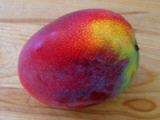The below was sent in from my blog of a few days ago. One of our followers was nice enough to pull this article from 2008 to share with all of you that may fall into my trap of Mango poisoning.
By the way, I am getting back to normal.
| Written by Playacommunity.com |
| Wednesday, 04 June 2008 05:54 |
 We are in the full of mango season! The trees are filled with tons of delicious, sweet mangos falling to the ground in the dozens. Did you know that mangos can cause a skin allergy if they are not properly washed? A number of people have already experienced this. The following is an article by Zenaida Serrano, that was published in the Honolulu Advertiser . It explains how this happens: We are in the full of mango season! The trees are filled with tons of delicious, sweet mangos falling to the ground in the dozens. Did you know that mangos can cause a skin allergy if they are not properly washed? A number of people have already experienced this. The following is an article by Zenaida Serrano, that was published in the Honolulu Advertiser . It explains how this happens:File these under things that may give you a severe rash: Poison ivy, poison oak and ... hold up ... mango? Blame it on a chemical called urushiol, which is found in the oil of mango sap.
"That chemical is also found in poison oak and poison ivy, so people who have a history of reaction to poison oak and poison ivy would also react to this," said Dr. James Sweet of the Asthma, Allergy and Sinus Center of Hawai'i. "They should be cautious about handling mango."
While there are different types of reactions to mango, the most common is an itchy skin condition called allergic contact dermatitis, caused by an allergic reaction to material in contact with the skin, Sweet said.But the good news about this type of allergy is that the fruit itself is still safe to eat. It's the oil in the sap found outside the fruit that causes allergic contact dermatitis among certain people, he said. When those who are allergic come in contact with the sap — whether by touching a mango tree's leaves, bark or stems, or the skin of the fruit — it may result in itching, redness, blisters and/or hives. However, reaction is not immediate, often happening 12 to 24 hours after contact, even up to 48 hours later. If left untreated, the condition can last one to three weeks before it resolves itself. The rash may be treated with an over-the-counter 1 percent cortisone cream, Sweet said. If the rash spreads or becomes intolerable, see a doctor who could prescribe a potent steriod cream or cortisone pills, such as prednisone. Sweet offers these tips to those who may be prone to mango allergies, specifically allergic contact dermatitis:
|
No comments:
Post a Comment